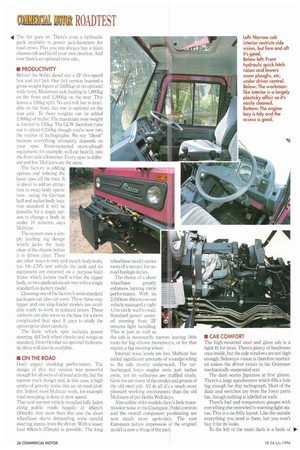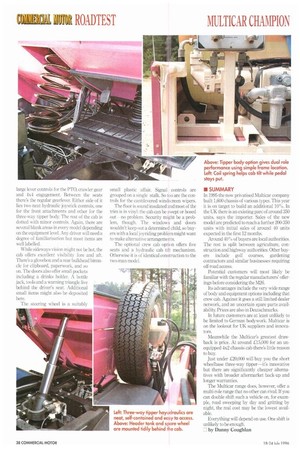MULTIPLE PERSONALITY
Page 36

Page 38

Page 40

If you've noticed an error in this article please click here to report it so we can fix it.
With high useage now the name of the efficiency game, multiple-role vehicles look increasingly attractive—not least among cash-strapped municipals and utilities. Can Multicar's latest offering beat those budgetry blues?
Take four wheels, a narrow chassis and a cab to match. Assemble and serve. Nothing new in that. Yet what might make this particular dish so attractive is its wide range of garnish. Defining the latest Multicar is almost impossible. It could be a truck, or it could be a piece of plant. Whatever you think of its looks Mercedes-Benz thought the concept so appealing it recently unveiled its own version, the UX MO (CM 13-19 June 1996). Flattery or phobia? CM aimed to find out.
In any event the abilities of this combination of 4x4iPTO/power pack/bodywork are limited mostly by the operator's imagination. There are a hundred major variants plus myriad options from which to choose.
• PRODUCT PROFILE The latest M26 Champion model, built in the former east Germany, is powered by keen's familiar 2.5-litre turbo diesel engine—the same unit as fitted in the Turbo Daily. This option came on-line last year. The previous engine was a Volkswagen unit. Everything else is locally engineered. This means the chassis, cab, axles and multi-role transmission are either home-grown or liwnsed assemblies. In almost every case the corn ponentry is German in origin and unique to Mu lticar Like every Mutt icar ever seen the concept is aimed at local authorities, the utility companies, hauliers, foresters, farmers, indeed anyone who needs something a little different. The vehicle's primary aims are a narrow track to provide good access, it's also light and manoeuvrable. Added to this is a multi-role function. As a result the catalogue includes ex-factory tippers, road sweepers and even a rapid intervention airport-style crash tender. With added third-party attachments M26 becomes a harvester, a grass cutter, a gritter, snow blower, snow plough, spreader, crane, skip loader, gully sucker or a cherry picker. ..10 The list goes on. There's even a hydraulic pack available to power jack-hammers for road crews. Plus you can always buy a plain chassis cab and build your own creation. And now there's an optional crew cab...
• PRODUCTIVITY
Behind the Sotim diesel sits a ZF five-speed box arid lx I link. Our 4x4 version boasted a gross weight figure of 3.850kg on its optional wide tyro-5.. Maximum axle loading is 1,800kg on the front and 2,200kg on the rear This leaves a 150kg split. No anti-roll bar is available on the front, but one is optional on the rear axle. To these weights can be added 2,100kg of trailer. The maximum nose weight is limited to 120kg. The GCW therefore runs out to about 6250kg though you're now into the realms of tachographs. We say "about" because everything ultimately depends on your spec, Front-mounted snow-plough equipment, for example, will eat heavily into the front axle allowance, Every spec is different and few Mu 'nears are the same.
The factory is adding options and refining the basic spec all the time, It is about to add an attraction to swap body operators-using the German ball and socket body location standard it will be passible for a single person to change a body in under 10 minutes, says Multicar.
The system uses a simple landing leg desigr which jacks the bocl clear of the chassis before it is driven clear. There are other ways to mix and match bodywork, too. On CM's test vehicle the tank and its equipment are mounted on a purpose-built frame which locates itself within the tipper body, so two applications are met with a single standard ex-factory model.
Choosing one of the factory's semi-standard packages can also cut costs. Three three-way tipper and one skip-loader models are available ready to work at reduced prices. These variants can also serve as the base for a more complicated final spec. It pays to study the option/price sheet carefully.
The basic vehicle spec includes power steering. diff-lock wheel chocks and wings as standard. From October an optional hydrostatic drive will also be available.
• ON THE ROAD Don't expect stonking performance. The design of this 4x4 version was powerful enough for all sorts of off-road activity, but the narrow track design and, in this case, a high centre of gravity make this an on-road plodder. Indeed most Multicar work, for example road sweeping, is done at slow speed.
That said our test vehicle trundled fully laden along public roads happily at 48km/li (30mph). Any more than that and the short wheelbase starts demanding some careful steering inputs from the driver. With a lesser load 89km/h (55mph) is possible. The long wheelbase model seems more of a natural for onroad haulage duties. The choice of a short
wheelbase greatly enhances turning circle performance. With its 2,100mm dimension our vehicle managed a tight 4.7m circle wall-to-wall. Standard power assisted steering from 'LI' ensures light handling. This is just as well as the cab is necessarily narrow leaving little room for big elbows movements, or for that matter, a big steering wheel.
Internal noise levels are low. Multicar has added significant amounts of soundproofing to the cab. mostly underneath. The turbocharged Iveco engine rests just inches away, yet its outbursts are muffled nicely. Gone too are many of the creaks and groans of the old steel cab. All in all it's a much more pleasant working environment than the old Multicars of pre-Berlin Wall days.
Also unlike older models there's little transmission noise in the Champion. Pedal controls and the overall component positioning are now much more up-to-date. The east European nature impression of the original model is now a thing of the past • CAB COMFORT The high-mounted steel and glass cab is a tight fit for most. There's plenty of headroom once inside, but the side windows are not high enough. Sideways vision is therefore restricted unless the driver twists in his Grammer mechanically suspended seat.
The dash seems Japanese at first glance. There's a large speedometer which fills a hole big enough for that tachograph. Most of the dials and switches are from the Iveco parts bin, though nothing is labelled as such.
There's fuel and temperature gauges with everything else restricted to warning light status. This is a no frills layout. Like the outside everything you need is there, but you won't buy it for its looks.
To the left of the main dash is a bank of 111. large lever controls for the PTO, crawler gear and 1x4 engagement. Between the seats there's the regular gearlever. Either side of it lies Iwo neat hydraulic joystick controls, one for the front attachments and other for the three-way tipper body. The rest of the cab is dotted with minor controls. Again, there are several blank areas in every model depending on the equipment level. Any driver will need a degree of familiarisation but most items are well labelled.
While sideways vision might not be hot, the cab offers excellent visibility fore and aft. There's a glovebox and a rear bulkhead binnacle for clipboard, paperwork, and so on. The doors also offer small pockets including a drinks holden A bottle jack, tools and a warning triangle live behind the driver's seat. Additional small items might also be deposited here.
The steering wheel is a suitably small plastic affair. Signal controls are grouped on a single stalk. So too are the controls for the cantilevered windscreen wipers.
The floor is sound insulated and most of the trim is in vinyl: the cab can be swept or hosed out no problem. Security might be a problem, though. The windows and doors wouldn't keep out a determined child, so buyers with a local joyriding problem might want to make alternative arrangements.
The optional crew cab option offers five seats and a hydraulic cab tilt mechanism. Otherwise it is of identical construction to the two-man model. III SUMMARY In 1995 the now privatised MuIticar company built 1,600 chassis of various types. This year it is on target to build an additional 10°6. In the UK there is an existing pare of around 350 units, says the importer. Sales of the new model are predicted to reach a further 200-350 units with initial sales of around 40 units expected in the first 12 months.
Around 409-.0 of buyers are local authorities. The rest is split between agriculture, construction and highway authorities. Other buyers include golf courses, gardening contractors and similar businesses requiring off-road access.
Potential customers will most likely be familiar with the regular manufacturers' offerings before considering the M26.
Its advantages include the very wide range of body and equipment options including that crew cab. Against it goes a still limited dealer network, and an uncertain spare parts availability. Prices are also in Deutschniarks.
In future customers are at least unlikely to be limited to German bodywork. Mutticar is on the lookout for TJK suppliers and innovators.
Meanwhile the Multicar's greatest drawback is price. At around L15,000 for an unequipped 4x2 chassis cab there's little reason to buy.
Just under £20,000 will buy you the short wheelbase three-way tipper—it's innovative but there are significantly cheaper alternatives with broader aftermarket back-up and longer warranties.
The Multi= range does, however, offer a multi-role range that no other can rival. If you can double shift such a vehicle on, for example, road sweeping by day and gritting by night, the real cost may be the lowest available.
Everything will depend on use. One shift is unlikely to be enough.
by Danny Coughlan












































































































